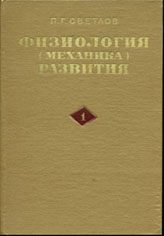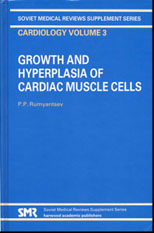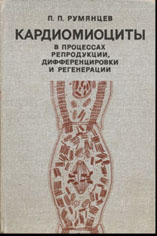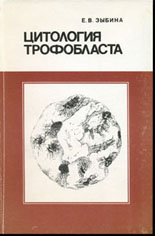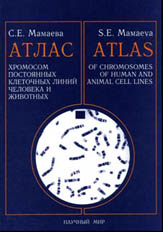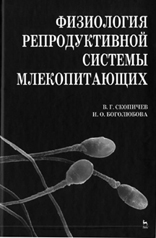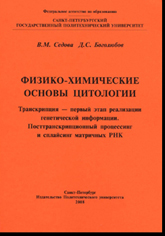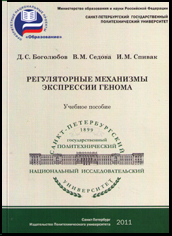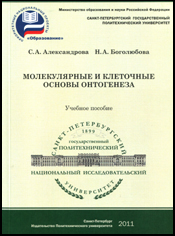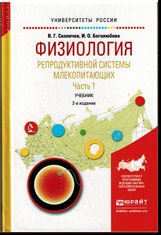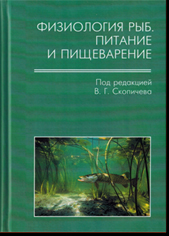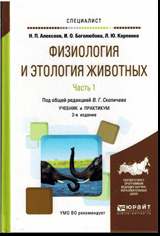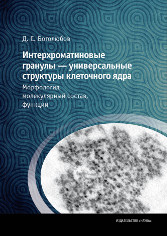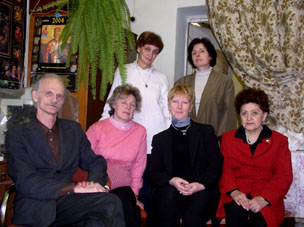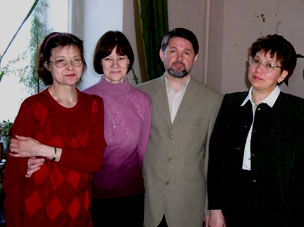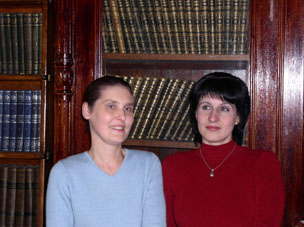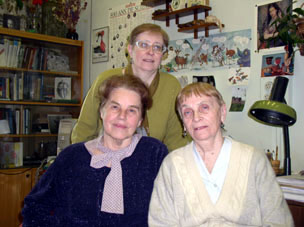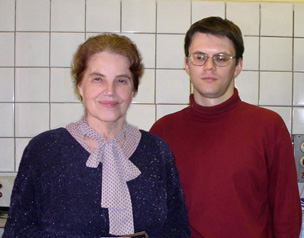| Laboratory of Cell Morphology |
|
Head of the Laboratory Dmitry S. BOGOLYUBOVD.Sci.Phone: +7 (812) 297-18-36
|
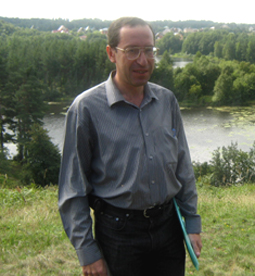
|
|
The Laboratory of Cell Morphology exists since the Institute of Cytology was established. The Laboratory was found by the eminent cytogenetists and zoologist
I.I. Sokolov. He was the head of the Laboratory since 1957 until 1959. Professor Sokolov placed high emphasis on the studies of gametogenesis, particularly oogenesis.
Then, the Laboratory was headed by Professor L.N. Zhinkin (since 1959 until 1971) who extended the frame of studies to histogenesis, mitotic cycle, differentiation
and regeneraton of the somatic cells (mainly muscle cells) and generally introduced the autoradiography as a new method. Professor P.P. Rumyantsev, a vice
academician of Soviet Academy of Sciences, was the head of the Laboratory since 1971 until 1988. He established a new line of investigation: the study of cardiomyocytes.
Together with his apprentices, he brilliantly developed this line being prominent world-wide specialist in this field.
Since 1988 until 2012, the Laboratory was headed by Professor V.N. Parfenov. He had begun his scientific career here as a post-graduate student and then got the position of Head of the Laboratory and the Director of the Institute. Professor Parfenov gave a new impulse for studies of the organization and function of oocyte nuclear structures keeping at the same time all previous lines of studies. He extended the range of objects and contributed some pioneering methods including immunocytochemistry on light and electron microscopic (immunogold) levels. In 1957-1968, a noted cytologist, future head of the Department of Histology and Cytology at the Saint-Petersburg University, Professor A.A. Zavarzin, Jr. worked at the Laboratory. In 1966-1974, the first-rate embryologist, a vice academician of Soviet Academy of Medical Sciences, Professor P.G. Svetlov also worked there. The main part of studies is being carried out in the frame of the interlaboratory government topic "Molecular structure, composition and dynamics of chromosomes and the extrachromosomal nucleoplasmic domains of different cell types in phylogenetically distant organisms" (No. 01201351105). In 1988, a series of publications by E.V. Raikova on the cytology of the unique intracellular parasite of acipenserid oocytes, Polypodium hydriforme (Cnidaria), and the cytology of the oogenesis of acipenseriform fishes was awarded by the Alexander Kowalevsky Medal from the Presidium of Soviet Academy of Sciences. In different years, the collaborators of the Laboratory have written and published some monographs, textbooks and manuals on the cytology:
At the present time, the collaborators of the Laboratory give courses of lectures at Saint-Petersburg State University, Saint-Petersburg Polytechnic University, Central Lecture Center, medical institutions and universities of Saint-Petersburg and take part in writing of textbooks and manuals for students. The work was repeatedly supported by grants of Fogarty Foundation, Russian Fund for Basic Research, Soros Foundation, National Science Support Foundation, Government of Saint-Petersburg, Presidium of Russian Academy of Sciences, and the grant program "Leading Scientific Schools of Russian Federation". |
Chief Research Associate Dmitry S. Bogolyubov, Ph.D., D. Sci.
Principal Research Associates
Senior Research Associates
Research Associates
Junior research Associates
Senior Laboratory Assistants
Technician
|
|
Lines of investigations The investigations at the Laboratory are carried out on wide-ranged objects using complex approaches including light and electron microscopy, cyto- and histochemistry, light and electron autoradiography, cytophotometry, indirect light and electron (immunogold) microscopy, confocal laser scanning microscopy, hybridization in situ, microinjections, protein electrophoresis, Western blotting, etc. At the present time, the studies are carried out on the following lines: |
|
I. FUNCTIONAL MORPHOLOGY OF NUCLEAR STRUCTURES IN OOGENESIS
The Head: D.S. Bogolyubov, Ph.D, D.Sci.
Complex studies of the organization, dynamics, molecular composition and functions of chromosomal and nucleolar apparatus as well as extrachromosomal nuclear domains
of oocytes are carried out on broad-ranged objects including some platyhelmints, mollusks, different insects, amphibians, and mammals. The main attention is paid to the revealing
of peculiarities and the significance of the relations between Cajal bodies, nucleoli and interchromatin granule clusters (nuclear speckles) at active stages of oogenesis and under
physiologically determined inactivation of oocyte nuclei towards the end of oogenesis during karyosphere (karyosome) formation.
|
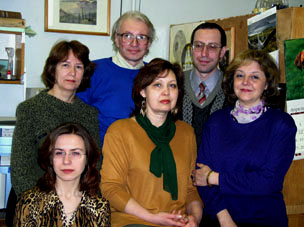
|
|
Main publications (1993-2018) Gruzova M.N., Parfenov V.N. (1993) Karyosphere in oogenesis and intranuclear morphogenesis. Int. Rev. Cytol. 144: 1-52. Wu Z., Murphy C., Wu C.-H.H., Tsvetkov A., Gall J.G. (1993) Snurposomes and coiled bodies. Cold Spring Harb. Symp. Quant. Biol. 58: 747-754. Gall J.G., Tsvetkov A., Wu Z, Murphy C. (1995) Is the sphere organelle/coiled body a universal nuclear component? Dev. Genet. 16: 25-35. Parfenov V.N., Davis D.S., Pochukalina G.N., Sample C.E., Bugaeva E.A., Murti K.G. (1995) Nuclear actin filaments and their topological changes in frog oocytes. Exp. Cell Res. 217: 385-394. Parfenov V.N., Davis D.S., Pochukalina G.N., Sample C.E., Murti K.G. (1996) Nuclear bodies of stage 6 oocytes of Rana temporaria contain nucleolar and coiled body proteins. Exp. Cell Res. 228: 229-236. Tsvetkov A., Alexandrova O., Bogolyubov D., Gruzova M. (1997) Nuclear bodies from the cricket and mealworm oocytes contain splicing factors of pre-mRNA. Eur. J. Entomol. 94: 393-407. Parfenov V.N., Davis D.S., Pochukalina G.N., Kostyuchek D.F., Murti K.G. (1998) Dynamics of distribution of splicing components relative to the transcriptional state of human oocytes from antral follicles. J. Cell. Biochem. 69: 72-80. Bogolyubov D., Alexandrova O., Tsvetkov A., Parfenov V. (2000) An immunoelectron study of karyosphere and nuclear bodies in oocytes of mealworm beetle, Tenebrio molitor (Coleoptera: Polyphaga). Chromosoma. 109: 415-425. Parfenov V.N., Davis D.S., Pochukalina G.N., Kostyuchek D. Murti K.G. (2000) Nuclear distribution of RNA polymerase II in human oocytes from antral follicles: dynamics relative to the transcriptional state and association with splicing factors. J. Cell. Biochem. 77: 654?665. Bogolyubov D., Parfenov V. (2001) Immunogold localization of RNA polymerase II and pre-mRNA splicing factors in Tenebrio molitor oocyte nuclei with special emphasis on karyosphere development. Tiss. Cell. 33: 549-561. Parfenova H., Parfenov V.N., Shlopov B.V., Levine V., Falkos S., Pourcyrous M., Leffler C.W. (2001) Dynamics of nuclear localization sites for COX-2 in vascular endothelial cells. Am. J. Physiol. Cell. Physiol. 281: C166-C178. Batalova F., Parfenov V. (2003) Immunomorphological localization of Vasa protein and pre-mRNA splicing factors in Panorpa communis trophocytes and oocytes. Cell Biol. Int. 27: 795-807. Parfenov V.N., Pochukalina G.N., Davis D.S., Reinbold R., Scholer H.R., Murti K.G. (2003) Nuclear distribution of Oct-4 transcription factor in transcriptionally active and inactive mouse oocytes and its relation to RNA polymerase II and splicing factors. J. Cell. Biochem. 89: 720-732. Bogolyubov D., Parfenov V. (2004) Do nuclear bodies in oocytes of Tenebrio molitor (Coleoptera: Polyphaga, Tenebrionidae) contain two forms of RNA polymerase II? Tiss. Cell. 36: 13-17. Batalova F.M., Stepanova I.S., Skovorodkin I.N., Bogolyubov D.S., Parfenov V.N. (2005) Identification and dynamics of Cajal bodies in relation to karyosphere formation in scorpionfly oocytes. Chromosoma. 113: 428-439. Parfenova H., Parfenov V., Leffler C. (2005) Nuclear functions of cyclooxygenase in cerebral vascular endothelial cells. In: Biochemistry of Lipids in Vascular Functions. M. Alberghina, ed. pp. 63-83. Stepanova I.S., Bogolyubov D.S., Skovorodkin I.N., Parfenov V.N. (2007) Cajal bodies and interchromatin granule clusters in cricket oocytes: composition, dynamics and interactions. Cell Biol. Int. 31: 203-214. Bogolyubov D. (2007) Localization of RNA transcription sites in insect oocytes using microinjections of 5-bromouridine 5 -triphosphate. Folia Histochem. Cytobiol. 45: 129-134. Bogolyubov D.S., Batalova F.M., Ogorzalek A. (2007) Localization of interchromatin granule cluster and Cajal body components in oocyte nuclear bodies of the hemipterans. Tissue Cell. 39: 353-364. Bogolyubov D., Stepanova I. (2007) Interchromatin granule clusters in vitellogenic oocytes of the fleshfly, Sarcophaga sp. Folia Histochem. Cytobiol. 45: 401-403. Dolnik A.V., Pochukalina G.N., Parfenov V.N., Karpushev A.V., Podgornaya O.I., Voronin A.P. (2007) Dynamics of satellite binding protein CENP-B and telomere binding protein TRF2/MTBP in the nuclei of mouse spermatogenic line. Cell Biol. Int. 31: 316-329. Tolkunova E., Malashicheva A., Parfenov V.N., Sustmann C., Grosschedl R., Tomilin A. (2007) PIAS proteins as repressors of Oct4 function. J. Mol. Biol. 374: 1200-1212. Bogolyubov D., Parfenov V. (2008) Structure of the insect oocyte nucleus with special reference to interchromatin granule clusters and Cajal bodies. Int. Rev. Cell Mol. Biol. 269: 59-110. Bogolyubov D., Stepanova I., Parfenov V. (2009) Universal nuclear domains of somatic and germ cells: some lessons from oocyte interchromatin granule cluster and Cajal body structure and molecular composition. BioEssays. 31 (4): 400-409. Batalova F., Parfenov V. (2009) Factors related to RNA polymerase II transcription are localized in interchromatin granule clusters of Panorpa communis oocytes. Folia Histochem. Cytobiol. 47 (1): 123-126. Batalova F.M., Bogolyubov D.S., Parfenov V.N. (2010) Interchromatin granule clusters of the scorpionfly oocytes contain poly(A)+ RNA, heterogeneous ribonucleoproteins A/B, and mRNA export factor NXF1. Cell Biol. Int. 34 (12): 1163-1170. Bogolyubov D.S., Kiselyov A.M., Shabelnikov S.V., Parfenov V.N. (2012) Polyadenylated RNA and mRNA export factors in extrachromosomal nuclear domains of vitellogenic oocytes in the yellow mealworm Tenebrio molitor. Cell Tissue Biol. 6: 412-422. Pochukalina G.N., Parfenov V.N. (2012) Localization of actin and mRNA export factors in the nucleus of murine preovulatory oocytes. Cell Tissue Biol. 6: 423-434. Bogolyubova I.O., Bogolyubov D.S. (2013). Oocyte nuclear structure during mammalian oogenesis. In: Recent Advances in Germ Cells Research. (Perrotte A., Ed.). Nova Biomedical. pp. 105-132. Bogolyubov D.S., Batalova F.M., Kiselyov A.M., Stepanova I.S. (2013). Nuclear structures in Tribolium castaneum oocytes. Cell Biol. Int. 37: 1061-1079. Pochukalina G.N., Stepanova I.S. 2014. Interchromatin granule clusters of mouse preovulatory oocytes are enriched with some components of mRNA export machinery. Annu. Res. Rev. Biol. 4: 79-92. Ilicheva N.V., Kiryushina D.Y., Baskakov A.V., Podgornaya O.I., Pochukalina G.N. 2016. The karyosphere capsule in oocytes of hibernating frogs Rana temporaria contains actin, lamins and SnPNP. Cell Tiss. Biol. 10: 422–429. Pochukalina G.N., Ilicheva N.V., Podgornaya O.I., Voronin A.P. 2016. Nucleolus-like body of mouse oocytes contains lamin A and B and TRF2 but not actin and topo II. Mol. Cytogen. 9: 50. Stepanova I.S., Bogolyubov D.S. 2017. Localization of the chromatin-remodeling protein ATRX in the oocyte nucleus of some insects. Cell Tiss. Biol. 11: 416–425. Kiselev A.M., Stepanova I.S., Adonin L.S., Batalova F.M., Parfenov V.N., Bogolyubov D.S., Podgornaya O.I. 2017. The exon junction complex factor Y14 is dynamic in the nucleus of the beetle Tribolium castaneum during late oogenesis. Mol. Cytogenet. 10 : 41. Bogolyubov D. 2018. Karyosphere (karyosome): A peculiar structure of the oocyte nucleus. Int. Rev. Cell Mol. Biol. 337: 1–48. Ilicheva N., Podgornaya O., Bogolyubov D., Pochukalina G. 2018. The karyosphere capsule in Rana temporaria oocytes contains structural and DNA-binding proteins. Nucleus. 9 (1): 516–529. * The names of the laboratory staff are in bold. Updated: January 2018 |
